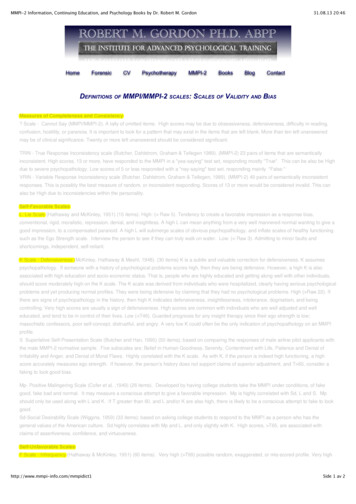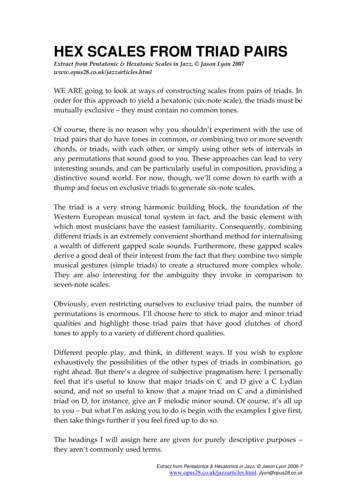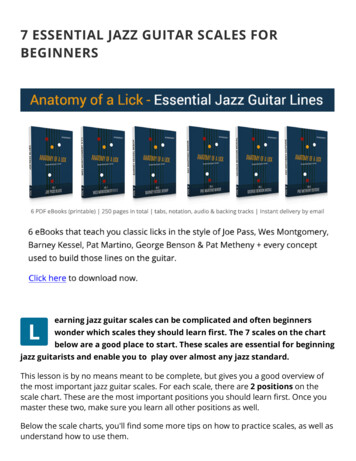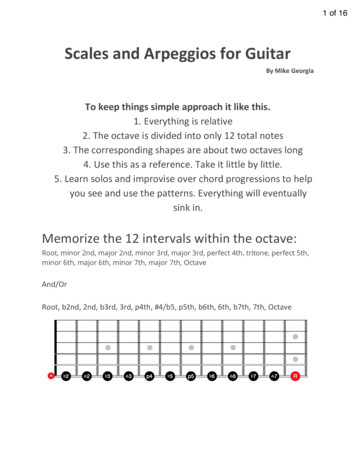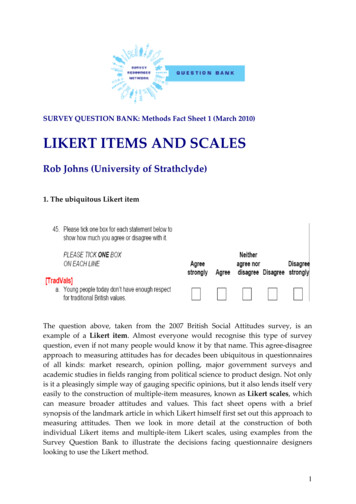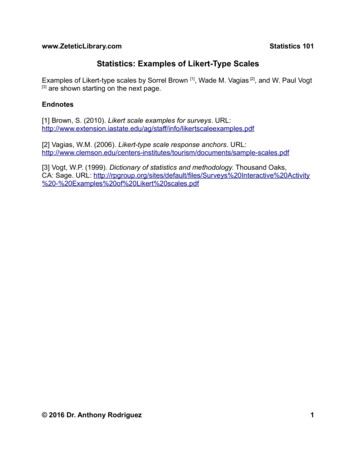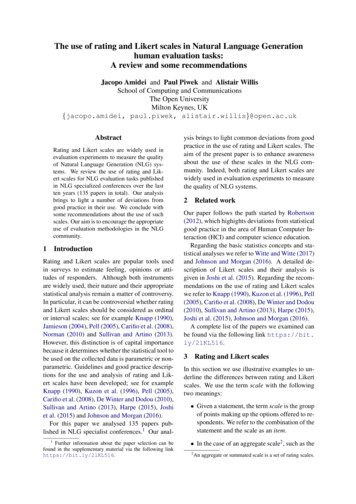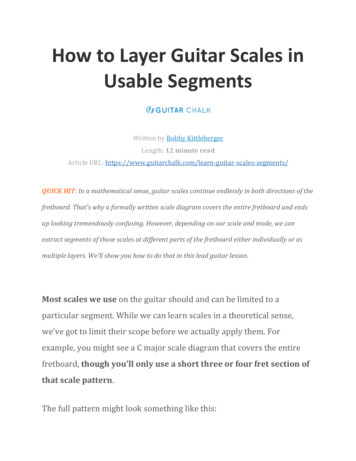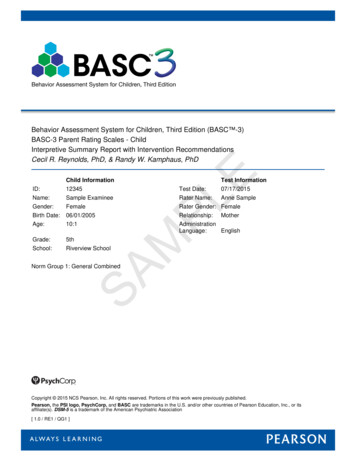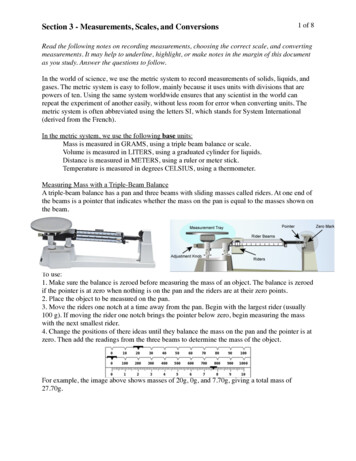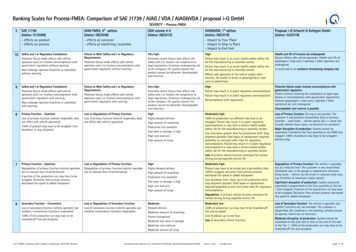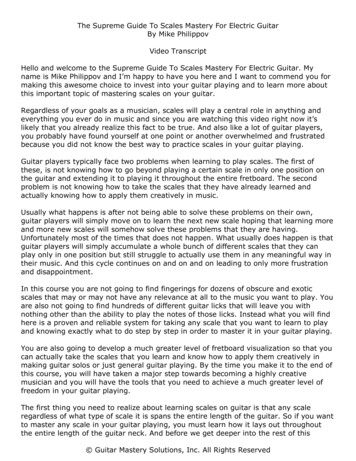
Transcription
The Supreme Guide To Scales Mastery For Electric GuitarBy Mike PhilippovVideo TranscriptHello and welcome to the Supreme Guide To Scales Mastery For Electric Guitar. Myname is Mike Philippov and I’m happy to have you here and I want to commend you formaking this awesome choice to invest into your guitar playing and to learn more aboutthis important topic of mastering scales on your guitar.Regardless of your goals as a musician, scales will play a central role in anything andeverything you ever do in music and since you are watching this video right now it’slikely that you already realize this fact to be true. And also like a lot of guitar players,you probably have found yourself at one point or another overwhelmed and frustratedbecause you did not know the best way to practice scales in your guitar playing.Guitar players typically face two problems when learning to play scales. The first ofthese, is not knowing how to go beyond playing a certain scale in only one position onthe guitar and extending it to playing it throughout the entire fretboard. The secondproblem is not knowing how to take the scales that they have already learned andactually knowing how to apply them creatively in music.Usually what happens is after not being able to solve these problems on their own,guitar players will simply move on to learn the next new scale hoping that learning moreand more new scales will somehow solve these problems that they are having.Unfortunately most of the times that does not happen. What usually does happen is thatguitar players will simply accumulate a whole bunch of different scales that they canplay only in one position but still struggle to actually use them in any meaningful way intheir music. And this cycle continues on and on and on leading to only more frustrationand disappointment.In this course you are not going to find fingerings for dozens of obscure and exoticscales that may or may not have any relevance at all to the music you want to play. Youare also not going to find hundreds of different guitar licks that will leave you withnothing other than the ability to play the notes of those licks. Instead what you will findhere is a proven and reliable system for taking any scale that you want to learn to playand knowing exactly what to do step by step in order to master it in your guitar playing.You are also going to develop a much greater level of fretboard visualization so that youcan actually take the scales that you learn and know how to apply them creatively inmaking guitar solos or just general guitar playing. By the time you make it to the end ofthis course, you will have taken a major step towards becoming a highly creativemusician and you will have the tools that you need to achieve a much greater level offreedom in your guitar playing.The first thing you need to realize about learning scales on guitar is that any scaleregardless of what type of scale it is spans the entire length of the guitar. So if you wantto master any scale in your guitar playing, you must learn how it lays out throughoutthe entire length of the guitar neck. And before we get deeper into the rest of this Guitar Mastery Solutions, Inc. All Rights Reserved
course there is a very important video that I want you to watch that goes over thefundamentals of what it means to practice scales all over the guitar.You may have already seen this video before on my website, but regardless, it will bevery beneficial for you to either go and watch this video now if you have not seen itbefore, or even if you have watched it in the past it will also be helpful for you to go andreview it once more so that these concepts are very clear in your mind before wecontinue. So go and watch this video now (you can find the link to it eguitarscalesvideo.html ), and whenyou are done, you can come back here and we are going to pick up from where thatvideo left off, talking about some more advanced and a lot more fun concepts that arenot discussed it the free version of the video. So go on and check this video right nowand I will see you back here in a few minutes.Okay, now that you understand more about the fundamentals of practicing scales andyou also understand more about how scales are laid on guitar, it is time for your firstpracticing assignment. With this course, you have received a PDF document thatcontains fingerings for a variety of scales that are most commonly used in music.The first one I want you to look at is the set of fingerings for the major scale shown toyou in the key of A Major. What I want you to do is take the seven shapes of the majorscale that you see in the PDF document and spend about the next 2 weeks or so gettingthose shapes completely memorized. If you spend about two days or two practicesessions on each shape drilling it over and over before moving on to the next one, thatmeans in about two weeks or 14 days time you are going to have all seven of thoseshapes memorized. And the good news is after you learn those seven shapes you will beable to move them up and down in order to play the major scale in any key on theguitar. So you only have to learn one set of major scales and that will enable you to playthem in any key. We will talk a lot more about what that means later in this course.There are many good reasons why you should do this assignment right now. The firstone is that having the knowledge of how the major scale is laid out on guitar and havingthe ability to play all seven of the shapes of the major scale on guitar will make it a loteasier to understand and apply the material you will learn later in this course. And inaddition, (speaking generally) practicing scales all over the guitar neck is a greatexercise for your technique that will enhance your 2 hand synchronization specifically.If you already know how to play the 7 shapes of the major scale, then you can skip thisassignment and continue watching this video until you get you get to your nextassignment that will come a little bit later. But if you do not have this skill down yet,then it is very important for you to not move on until you have those seven shapescompletely memorized.The speed at which you can play these scales is not important for this assignment - infact it does not matter at all. All that matters is that you are able to play these scales allthe way through without stopping and without having to think about what notes comenext. After you have this skill down at least to that level you will be ready to move on,but please do not make the mistake of rushing through the rest of this course and notdoing any of the assignments. If you really want to improve your guitar playing, then Guitar Mastery Solutions, Inc. All Rights Reserved
you will get a lot more benefit from doing these assignments in the order in which I givethem to you before moving forward.Okay, now that you have some experience of actually practicing scales all over theguitar neck, it is time to talk about the next very important topic that all great guitarplayers master in the process of learning to be free with playing scales on guitar andthat topic is scale sequences. Scales are said to be played in a sequence, when insteadof playing the notes of the scale linearly or one note after the other in a straight order, acertain pattern is picked and applied to the notes of the scale to create what is called asequence.To illustrate this visually, when you think about playing the scale one note after theother in a straight line, just think of a line literally moving up and moving down. Andwhen you think about a scale sequence, visualize the notes moving up and moving downin a manner similar to the steps of a staircase. In both cases, whether you will beplaying the scale linearly or by using a scale sequence, the goal is exactly the same. Youwant to get from the first note of the scale to the last note. But when using a scalesequence idea, a lot more musical interest is created and it is a lot more enjoyable tolisten to. And you will hear a lot of this in the examples that I will demonstrate to youthroughout this course.There are many reasons why it is important for you to learn about how scale sequenceswork and all of these reason will help you become a vastly better guitar player. Here iswhy. First, as you practice scale sequences, that automatically forces you to do a lot ofpracticing of the actual scale shapes from which the scale sequences are built. And it isobvious that the more time you spend on practicing the scale shapes, the better you willmemorize them and the easier it will become for you to actually to use them when itcomes time to play a guitar solo. The second reason is when it comes to playing actualmusic, scale sequences are used a lot more frequently than scales that are played in alinear way with one note after the other. This is especially true in the context of theguitar solo where scales sequences can be used as faster passages. So by practicingscale sequences you will be bridging the gap between practicing scales as a theoreticalexercise and actually being able to use them creatively in your guitar solos.The third reason why practicing scale sequence is important, is because doing so is anexcellent way to improve your guitar technique. In particular, your two handsynchronization, your picking articulation and your general ability to play things cleanlyon guitar will all improve as a result of practicing scale sequences. So in addition to theother benefits I mentioned, you will be come a better general guitar player as a result ofthis kind of practicing also. And last but not least, practicing scale sequences is simply alot more fun than just playing scales straight up and down.Before we begin talking about how to actually practice and create scale sequences inyour guitar playing, there are a couple more points that I want to make sure youunderstand about this topic. First, there are literarily hundreds of possibilities forcreating and playing scale sequences, and the purpose of this course is not for mesimply show all of them to you. Doing this would not only take far too long, but will alsosimply overwhelm you with too much information that you are not going to able to use. Guitar Mastery Solutions, Inc. All Rights Reserved
Remember that the goal is not for you to know every single scale sequence possibilitythat exists in order to be able to use them in your guitar playing. Instead the main thingthat you really need to know is what scale sequences are, how they can be created andhow you can apply this information to creating any scale sequence on your own anytimeyou need to do so in your music. So in this course you are going to get the tools to doexactly that.The second thing I wanted to mention is that scale sequences can be broken up intoseveral different groups or types. Within each type, there are many individual scalesequences that are possible. In this course we will deal with three main scale sequencegroups. The first one will be sequences played on one string at a time, the next one willbe scale sequences played on string pairs or two strings at a time, and finally we will getto scale sequences played on all six strings of the guitar.First I will introduce each group of scale sequences to you and show some examples ofhow they are constructed, then I’m going to show you how you can create thesesequences yourself and I will give you some assignments that will help you practice thisskill. And finally, in a later section of this course, I will show you how to put all of thesescale sequences together and how to actually start using them creatively in your music.Scale Sequences On A Single StringOkay, now we are ready to get started with talking about some actual examples of scalesequences, and the first group of sequences we’ll talk about will be scale sequencesplayed on one string at a time. With the PDF document you received with this course,there are some examples of scale sequences shown in there. And the first one I wantyou to look at is the example of an A Major scale sequence played on the high E string.That one sounds like this:[Audio Example 1] Guitar Mastery Solutions, Inc. All Rights Reserved
The most important thing I want you to notice about what I just played are the first fournotes of the scale sequences that sound like this (listen to the example on video).This is the pattern that sets up the scale sequence and this is the pattern that getsmoved up through the rest of the scale one note at a time. So rather than playing thescale one note after the other in a linear way like this:[Audio Example 1a]we instead set up a pattern that also moves through this scale one note at a time, butthe notes within each pattern are not occurring in a step-by-step order as they would ifyou play the scale simply straight up and straight down. You can see this for yourself ifyou look at the tab of the example within the PDF document. The first fragment of thescale sequence starts on fret number seven, which is the second note of the A Majorscale. Then it moves to the seventh note of the scale at the fourth fret, then it moves tothe fifth fret or the first note of the scale and then it moves again to the second note ofthe scale.So this is the pattern, and as you can see, the notes are not occurring one after theother. After this first pattern is played, it gets moved up to the next note of the scaleand it gets repeated. And then it gets moved up to the next note and repeated again,then the next note, then the next, then the next. Let me play it for you again, and if youdidn’t hear it the first time listen for how the pattern repeats as it moves up through thescale.[Audio Example 1] Guitar Mastery Solutions, Inc. All Rights Reserved
This way it takes a little bit longer to make your way through the scale to the highestnote, but as you can hear, a lot more musical interest is created by playing the scale inthis w
In this course you are not going to find fingerings for dozens of obscure and exotic scales that may or may not have any relevance at all to the music you want to play. You are also not going to find hundreds of different guitar licks that will leave you with nothing other than the ability to play the notes of those licks. Instead what you will find here is a proven and reliable system for .
